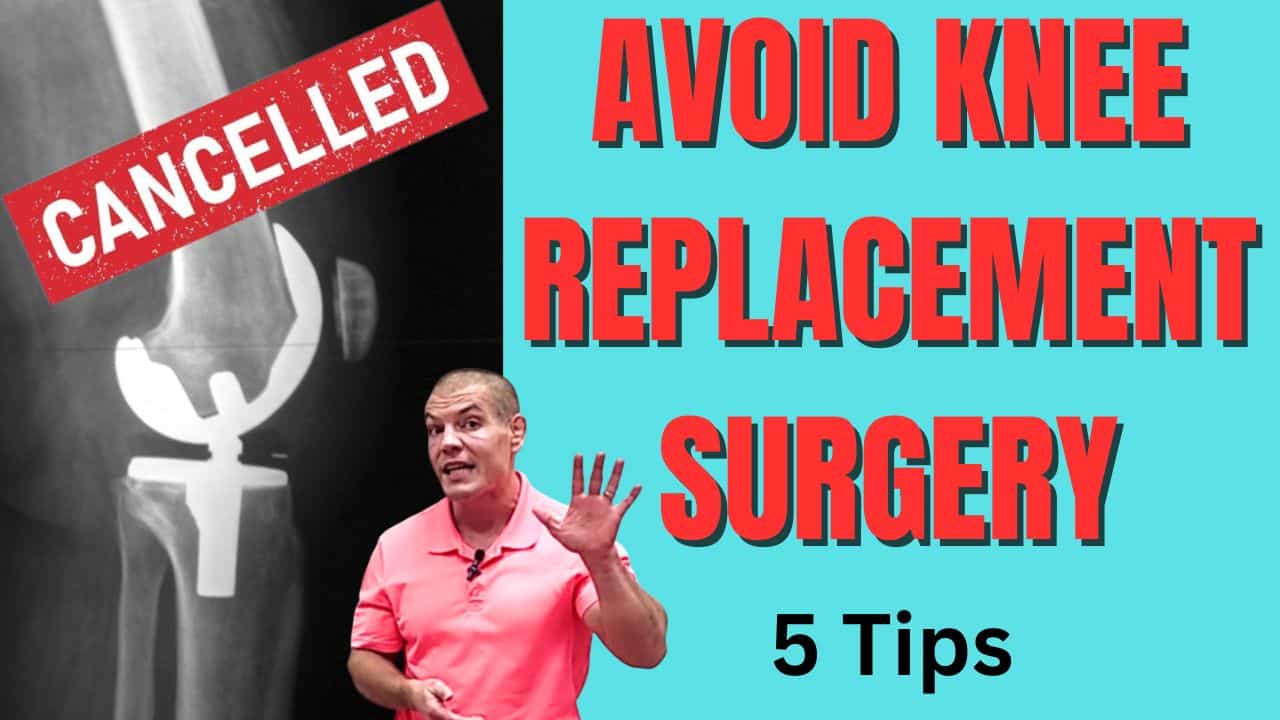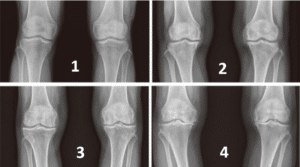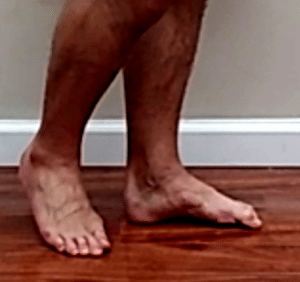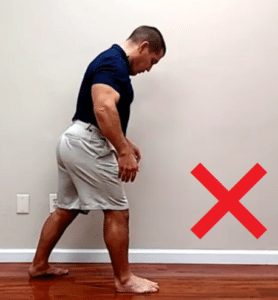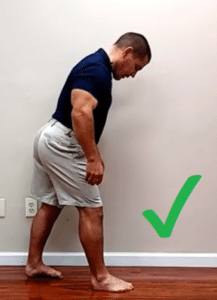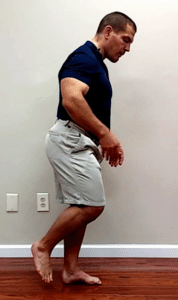If you have knee arthritis and you'd like to learn how avoid a knee replacement surgery, make sure to watch this video. In it, I'll share my top five tips to avoid knee replacement surgery.
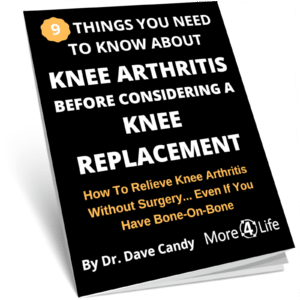
5 Tips To Avoid Knee Replacement Surgery
If you're even considering knee replacement surgery, make sure to try these 5 tips before scheduling a knee replacement.
Tip 1: Make Sure Your Knee Pain Is Actually Caused By Knee Arthritis
This one is very important.
If the thought of knee replacement has ever crossed your mind (and it probably has because you're reading this), make sure that your knee pain is actually coming from the arthritis on your X-ray.
Now, that sounds obvious, but it's very easy to see arthritis on the X-ray at your doctor's office, realize, "I do have knee pain that's pretty bad," and think that one is the cause of the other.
But there are many people with knee arthritis that don't have knee pain.
Furthermore, there are many different things besides arthritis that can cause knee pain, for example, muscles, tendons, ligaments, bursa, fat pads, and nerves.
And if any of those things are causing your knee pain, then you should avoid a knee replacement.
A knee replacement will not help you in this case.
Furthermore, it may actually make the problem worse because you've just gone and irritated all the tissues inside your knee without actually fixing the thing that was causing the pain in the first place.
That's why roughly 20% or one in five knee replacements fail to give people the amount of relief they were hoping for because there were other structures that were causing it, and that may not have been an ideal person for the surgery in the first place.
So you do want to make sure that if you're having a knee replacement, that the pain is actually coming from your knee joint.
So how do you tell that?
Well, number one is location.
If your pain is really coming from inside the joint, then the pain should feel like it's deep inside the joint or possibly behind the kneecap if you have kneecap arthritis or patellofemoral arthritis.
However, if you're having pain on the inner side of the knee, or the outside of the knee or the back of the knee, it's likely not coming from your knee arthritis.
Furthermore, if you can push somewhere on the knee and reproduce your pain, it's very unlikely that your arthritis is causing the knee pain.
Additionally, if you can straighten your knee all the way or bend your knee all the way, even if you have arthritis, it's probably not to the degree that you need a knee replacement.
That's because in the very severe degrees of arthritis, the grade threes and grade fours, you start to develop bone spurs or osteophytes inside your knee joint.
And when you have those bone spurs inside the joint, it prevents you from straightening fully or bending fully.
So that's tip number one: make sure that your pain is actually coming from arthritis.
Now, for the rest of these tips, we're going to assume that the pain is actually coming from the arthritis inside the joint.
So what do you do to avoid knee replacement surgery in that case?
Tip 2: Avoid Excessive Twisting In The Knee Joint
Your knee joint is primarily a forwards and backward joint.
It does have some degrees of side-to-side and rotation in it, and those are very important to normal knee function.
But if you get too much of that twisting and rotation, it twists and grinds the arthritic joint surfaces together.
Knee arthritis pain isn't necessarily caused by the presence of arthritis.
It's when those two worn-down joint surfaces grind on each other and cause inflammation. Then the inflammation is what causes the knee pain.
So if you can prevent too much twisting in your knee, you prevent the buildup of that inflammation.
Now, sports like golfing, tennis, or pickleball, where you do a lot of twisting at the hips, can cause twisting inside the knee joint.
But you can still continue to do those things in most cases if you have knee arthritis.
You just have to learn some modifications to cause less twisting in the knee joint.
Another big thing that causes twisting inside the knee joint is overpronation when you're walking.
Overpronation means that your foot is flattening out too much, and your knee is going inwards.
Now, what causes that?
Well, largely, it's not the knee itself. It has more to do with the foot and ankle and the hip.
In fact, I tell many people that knee problems largely are foot and ankle and hip issues in disguise.
So tip number three is going to address the foot and ankle component of overpronation.
Tip 3: Foot & Ankle Tips To Help Prevent A Knee Replacement Surgery
The two biggest things in the foot and ankle that cause overpronation are:
- weakness of the foot muscles,
- stiff calves
Weakness of the foot muscles
If your foot muscles aren't strong enough to support your arch, then you don't have a firm foundation to push off of.
Therefore, your knee is going to go inwards even if you have sufficient strength out of your hips.
So first of all, you need to be able to maintain your arch when you're walking.
You can do that by pulling the ball of your foot towards your heel and just slightly scrunching your toes.
That will, in most cases, turn your knee out a little bit and prevent it from overpronating or going into too much.
Stiff calves
Additionally, if you have too much stiffness in your calves, then when you go to take a step, you can't progress your body out in front of your foot.
As a result, your body has to find an alternate path around your foot. That's often pronating so that you can go around the foot.
But that, again, can contribute to too much twisting inside the knee joint.
So it is important to stretch your calves, but it's important that you stretch them properly.
A lot of people allow their foot to turn out and foot to flatten when stretching their calves.
That's actually causing pronation when you're trying to do something to prevent overpronation.
So you want to start out by doming your arch as we discussed above.
Then take a short step keeping that arch domed.
Keep your heel flat on the floor while stretching.
Ideally for at least a minute, preferably 90 seconds if you can, and that'll help you get more flexibility.
Now, if you have a good enough foundation in your foot, your foot muscles are strong enough, and your calves are flexible enough, another thing that can cause overpronation is your hip.
Tip 4: Strengthening Your Hip Can Help You Avoid Knee Replacement Surgery
If your hip muscles are too weak or your glute muscles are too weak, then it can cause your knee to go inwards.
You have three different glute muscles:
Your gluteus maximus (your butt muscle) on the back of the hips, and your gluteus medius and minimus on the sides.
Largely, it's the gluteus medius and the gluteus minimus that control that side-to-side motion.
So a good functional way to strengthen your gluteus medius and your gluteus minimus is just to practice standing on one foot with your arch domed.
If you don't have good enough balance to do this initially, you can hold onto a wall or a chair or a cane or a walker, anything to help keep you stable.
And then, once your balance improves, then you can start letting pressure off until you can do this on your own.
Being able to stand on one foot for 10 seconds or longer greatly reduces your fall risk in addition to helping to make your hip muscles stronger.
Another good glute-strengthening exercise is doing lunges or partial lunges.
That helps strengthen your gluteus maximus for activities like getting up and down from the floor, squatting to pick something up, and going up and down stairs.
So lunges are a very good functional glute-strengthening exercise.
Learn how to do lunges without knee pain here.
Tip 5: Walk, But Do It Correctly
Now, once you've made sure that your foot muscles are strong enough, your calves are flexible enough, and your glutes are strong enough, the next thing is to be able to walk farther.
Because honestly, it's the inability to walk as long or as far as you'd like that drives most people to seek out knee replacement surgery.
If you can walk longer with less knee pain, you probably won't need a knee replacement, even if you do have knee arthritis.
So how do you do that?
Well, one easy way is to take slightly shorter steps.
By taking shorter steps, you don't have to be on one foot for as long.
So if you've got some weakness in your hip muscles or in your arch muscles, it prevents how long you have to hold that position.
Additionally, if you don't have good flexibility in your calves, taking shorter steps prevents you from overpronating. That's because you don't need as much flexibility when you take shorter steps.
Now, eventually, you do want to work to be able to take longer steps.
However, in the short term, taking shorter steps will help you walk longer.
Walking is good for your cartilage health even if you have "bone-on-bone knee pain". (Usually there's at least some cartilage left.)
In addition, a tip that can help is using a cane or a walker for at least a short period of time while you're getting your hip muscles stronger and your foot muscles stronger and your calves more flexible.
Because walking is actually really good for your knee joint.
It helps improve your cartilage health and secretes a lubricating fluid called synovial fluid.
However, if every time you take a step, you're causing too much twisting at the knee, it's not good for you.
It's going to increase your knee pain.
Use an assistive devices to help unload your knee
Walking with a cane or walker will allow you to walk with less pressure on your knee.
And by walking longer and more often, you get stronger.
Furthermore, you improve your cartilage health, and you increase your chance of being able to avoid a knee replacement surgery.
Additionally, using a knee unloader brace may help take some pressure off of your knee when walking.
If you like the brace, you can buy the Knee OA Pro directly from DDS and save 10% using my discount code "DRCANDY10".
Or you can buy it on Amazon at full price.
Transparently, both of these are affiliate links so I earn a commission if you purchase through the links, but I only promote products that I actually believe are helpful.
Conclusion
So in conclusion, the five tips to avoid knee replacement surgery are:
- Make sure your pain is actually coming from the knee joint
- Avoid over-twisting your knee
- Strengthen your feet and stretch your calf muscles
- Strengthen your glute muscles
- Walk as much as you possibly can, but do it properly.
So hopefully, you did find this helpful, and you're able to avoid a knee replacement surgery.
Need More Help To Avoid Knee Replacement Surgery?
If you live in the St. Louis area and need help to relieve knee arthritis pain and avoid knee replacement surgery, just tap the button below to request an appointment with one of our specialist physical therapists.

